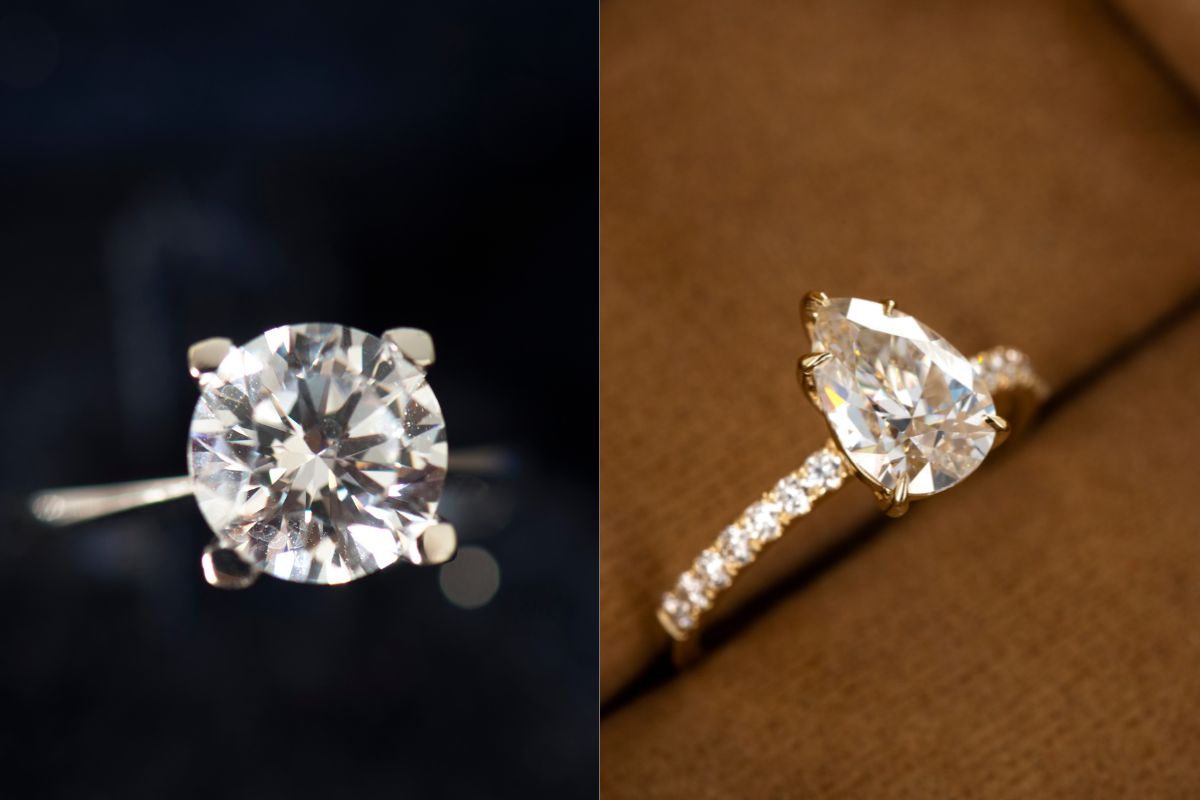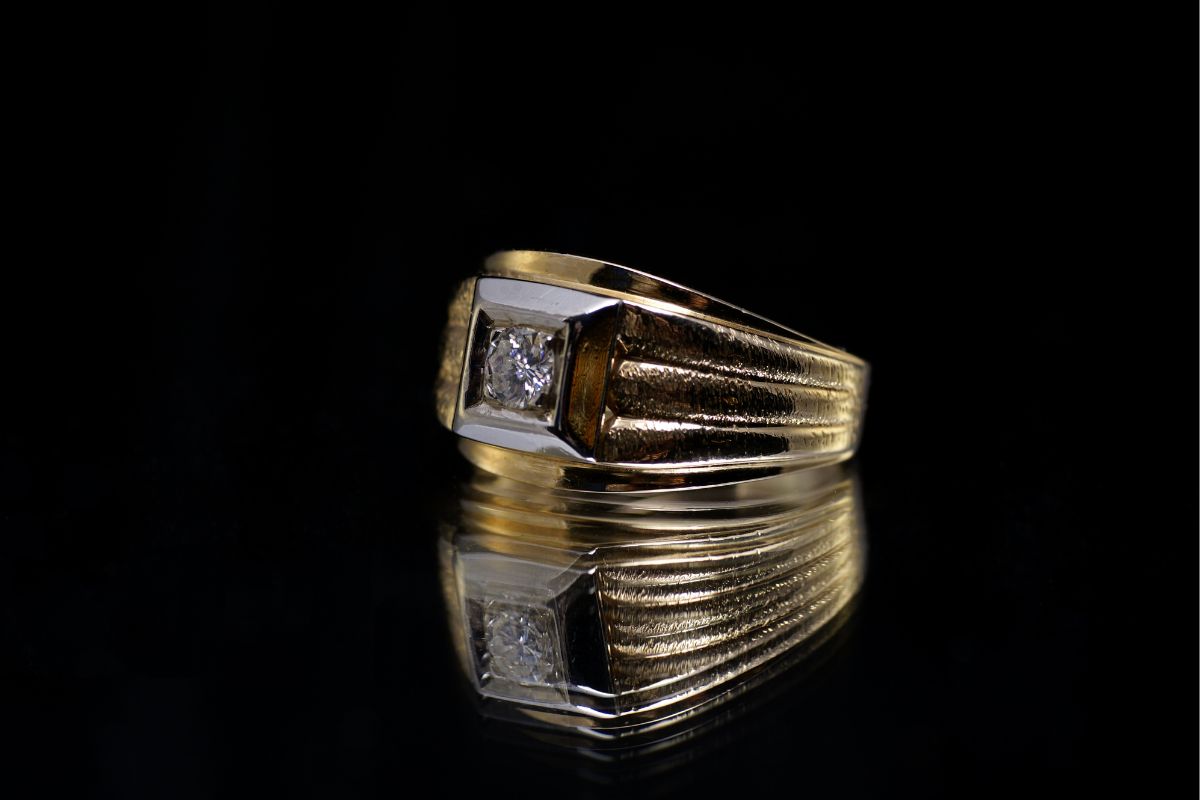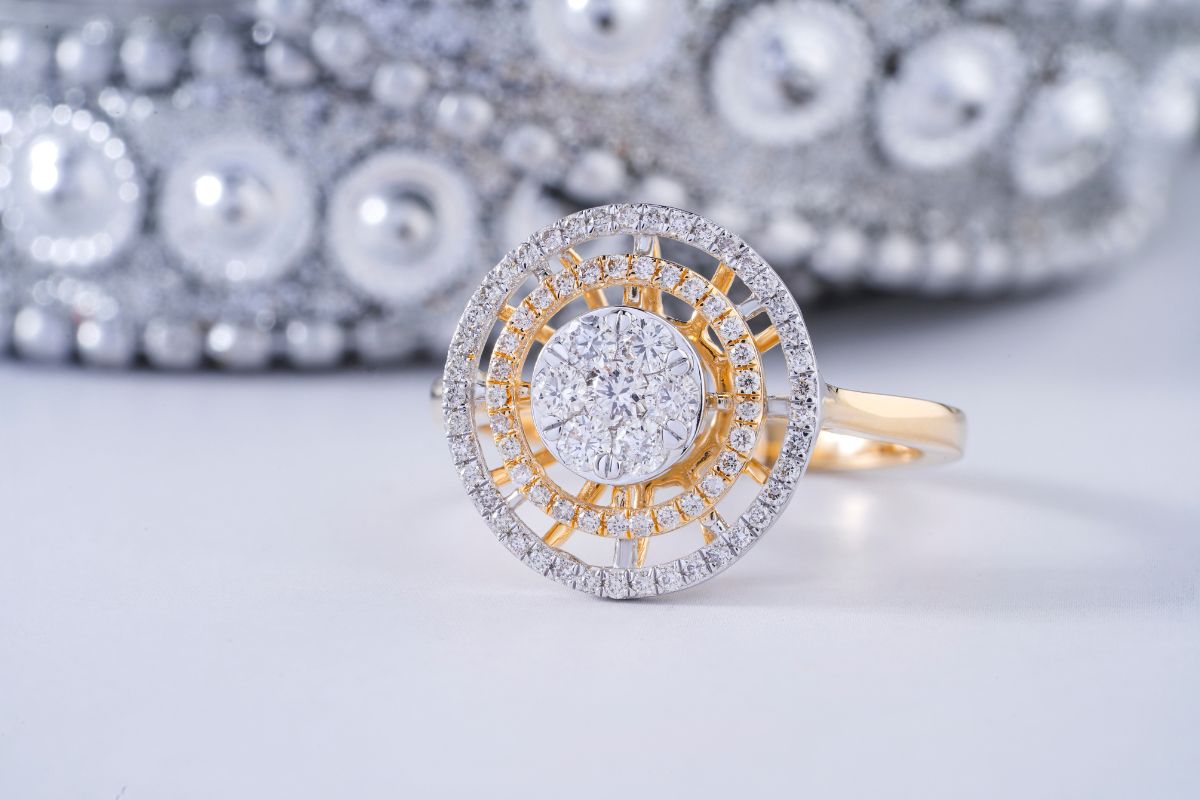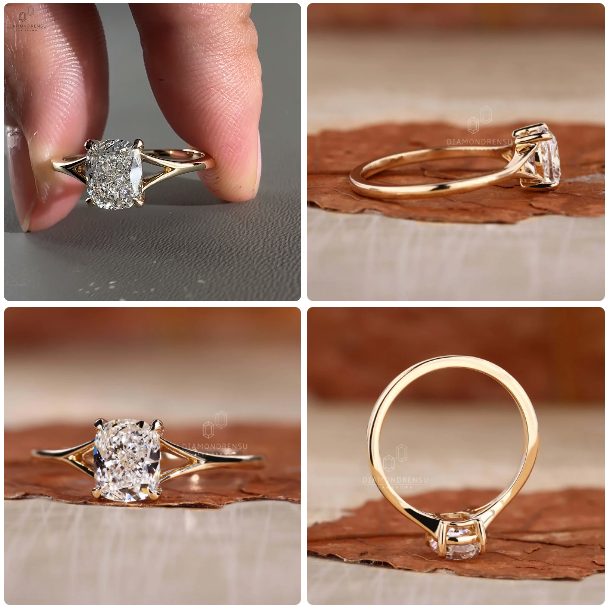
Solitaire vs Pave Engagement Rings: Deciding on the Perfect Style
When choosing an engagement ring, the setting is just as crucial as the diamond it holds. Two popular styles are solitaire and pavé, each offering a unique aesthetic and a range of practical considerations. Solitaire engagement rings feature a single diamond mounted on a simple band, spotlighting the stone's brilliance and beauty without additional ornamentation. It’s a timeless choice that emphasizes the central diamond, traditionally associated with a classic and elegant appearance.
On the other hand, pavé engagement rings are known for their extra sparkle. This style uses smaller diamonds, meticulously set close together along the band, creating a continuous line of shimmer that complements the center stone. This can enhance the ring's overall sparkle and give the illusion of a larger center diamond. Pavé settings can vary, with options like the French cut pavé which adds visual interest with distinctively cut pavé diamonds.
We must consider factors such as lifestyle, budget, and personal style when comparing solitaire and pavé engagement rings. Solitaires tend to appeal to those who appreciate a minimalist design or are looking for a ring that’s easy to maintain. Pavé settings, while potentially offering more sparkle and an ornate look, may come with higher maintenance to ensure the smaller diamonds remain secure. Understanding these differences aids in making a choice that aligns with both emotional desires and practicalities.
Understanding Engagement Ring Styles
When choosing an engagement ring, it’s crucial to understand the distinct styles of solitaire and pavé settings, each offering a unique aesthetic. We'll explore the definitions, intricacies, and design elements that set these styles apart.
Solitaire Engagement Rings
💍 Represents a single central gemstone, usually a diamond.
✨ Offers a classic and timeless design.
💎 Draws focus to the center stone, enhancing its brilliance.
Pavé Engagement Rings
💍 Features multiple small diamonds set closely together along the band.
🌟 Provides a dazzling and glamorous appearance.
🎆 Offers additional sparkle and brilliance from the pavé setting.
Definition of Solitaire Engagement Rings
A solitaire engagement ring features a single diamond or gemstone set prominently at the center, commonly held in place by prongs or a bezel setting. This style is celebrated for its timeless and minimalist appeal, drawing all attention to the central stone. The focus on a solitary diamond exemplifies a traditional and simple elegance that many find appealing.
Understanding Pavé Engagement Rings
On the other hand, pavé engagement rings are characterized by small diamonds encrusted along the band of the ring. The term pavé comes from the French word for 'paved,' reflecting the technique used to set tiny diamonds closely together, creating a continuous sparkling surface. This style often adds a unique and shimmering effect to the engagement ring, making it appear more intricate and luxurious.
Comparing Design and Aesthetics
When comparing the two, consider the following aspects:
- Visibility of Center Stone: Solitaire rings spotlight a single stone, often resulting in greater prominence and visibility. Pavé rings' additional small diamonds can enhance the center diamond's brilliance without overpowering it.
- Overall Brilliance: Pavé settings offer a dazzling array of light reflection, given the multitude of diamonds. In contrast, the solitaire's brilliance relies solely on the cut and quality of the central stone.
- Ring Style Complexity: Solitaires are typically more minimalist and understated, while pavé rings can range from simple designs to more complex, detailed patterns.
Each style caters to different tastes, with solitaires being the go-to for those seeking a more traditional, classic look, and pavé rings suiting those who desire something more ornate and distinctive. Both hold the potential to be timeless pieces that symbolize the enduring nature of love.
Evaluating Ring Settings

When selecting an engagement ring, we consider the setting to be a crucial aspect as it defines the ring's character and security of the gemstone.
| Aspect | Description |
|---|---|
| Ring Style |
Solitaire: Classic and timeless Pavé: Glamorous and dazzling |
| Band Width |
Solitaire: Typically thicker to highlight the center stone Pavé: Thinner to highlight diamonds along the band |
| Setting Type |
Solitaire: Single stone set prominently Pavé: Small diamonds set closely together |
| Maintenance |
Solitaire: Easier to clean and maintain Pavé: Needs more frequent cleaning |
| Price |
Solitaire: Generally more affordable Pavé: Usually higher due to added diamonds |
Solitaire Setting Characteristics
Solitaire settings are distinguished by their single diamond design. In these settings, the focus is solely on the central stone. We generally observe the following characteristics in a solitaire setting:
- Center Diamond: The single diamond takes center stage without any distraction.
- Metal Type: Strong metals are used to ensure the diamond's security.
- Maintenance: Easier to clean due to fewer crevices and maintenance needs are generally lower.
Features of Pavé Settings
For those of us who prefer an extra sparkle, pavé settings incorporate small diamonds along the band, which creates a paved appearance. Here's what stands out in pavé settings:
- Additional Diamonds: There are multiple small diamonds embedded along the band.
- Visual Appeal: This setting offers a glistening effect due to the abundance of diamonds.
- Maintenance: Higher maintenance as more diamonds can loosen or collect debris over time.
Other Popular Ring Settings
We also explore other setting types to provide a complete picture:
-
Halo Setting:
- Center diamond encircled by smaller diamonds to enhance its appearance.
- Offers a larger visual impact without a significant increase in carat size.
-
Bezel Setting:
- Metal rim surrounds and holds the gemstone in place.
- Offers excellent protection and a modern look.
-
Tension Setting:
- The diamond is held in place by pressure rather than prongs, which gives a floating appearance.
- Requires precise craftsmanship, hence it's a less common but unique option.
-
Prong Setting:
- Typically uses four to six prongs to hold the center stone.
- Allows maximum light to enter the stone and enhances brilliance.
Each of these settings carries its own unique appeal and considerations, such as visual style, security, and ease of maintenance.
Diamond and Stone Details

In choosing between solitaire and pavé engagement rings, one must consider the details of the center stone and accent stones, as well as the cut and quality of the diamonds, which greatly influence the ring's brilliance and sparkle.
The Role of the Center Stone
The center stone is the focal point of a solitaire engagement ring. It stands alone, thus its size, shape, and quality are paramount. We often see center stones in a variety of diamond cuts, such as round, princess, or cushion, each offering its unique shine and clarity. In a solitaire setting, the solitary diamond's brilliance is highlighted without competition from other stones.
Accent Stones and Their Impact
Pavé settings incorporate accent stones, which are smaller diamonds or stones lined along the band. These stones play a vital role in enhancing the ring’s overall sparkle. The addition of accent stones can magnify the shine, making the band itself a canvas of light and brilliance. Despite being secondary to the center stone, their quality should not be overlooked, as they contribute to the ring's collective gleam.
Diamond Cut and Quality
The diamond cut directly influences a diamond's reflective qualities and its ability to sparkle. A well-proportioned cut will enhance the stone's ability to reflect light, resulting in greater brilliance and shine. High quality in terms of cut and clarity is essential, whether it's for a solitary centerpiece or the numerous accent stones of a pavé setting. Our selection takes into account the grade of the cut ensuring that all diamonds meet high standards of clarity and sparkle.
Material and Metal Options
When selecting the material for an engagement ring, it's important for us to consider both the aesthetic and functional aspects of different metals. We'll explore the ideal metal types for solitaire and pavé styles, as well as the factors affecting their durability.
Metal Types for Different Styles
Solitaire Engagement Rings
💍 Classic and Timeless
✨ White Gold - Modern and Versatile
💎 Yellow Gold - Traditional and Warm
🌟 Rose Gold - Romantic and Elegant
🌌 Platinum - Luxurious and Durable
Pavé Engagement Rings
💍 Glamorous and Dazzling
✨ White Gold - Contemporary and Stylish
💎 Yellow Gold - Vintage and Classic
🌟 Rose Gold - Soft and Feminine
🌌 Platinum - High-End and Prestigious
- Gold: Particularly favorable for solitaire settings due to its timeless appeal. We have options like:
- 14k or 18k Yellow Gold: Classic and rich in color, enhancing the solitary diamond.
- White Gold: Offers a sleek, modern look that complements the diamond's brilliance.
Pavé Rings:
- Typically, we use Platinum for pavé settings because of its strength, which holds the smaller diamonds securely.
- Gold: While not as strong as platinum, both Yellow and White Gold are still popular for pavé bands, providing a good balance of durability and beauty.
Choosing the Right Metal for Durability
- Platinum: This metal is our top choice for maximum durability. Its density and weight make it ideal for securing diamonds in a pavé setting.
- Gold: Whether it’s yellow or white, gold is more malleable than platinum. For engagement rings that are worn daily, we recommend a higher karat gold band for added durability.
- Shank Considerations: For both solitaires and pavé rings, we must ensure that the shank the part of the ring that encircles the finger is made of metal that can withstand daily wear.
By carefully selecting the metal, we enhance the ring's aesthetic appeal and ensure that it stands the test of time.
Practical Considerations

When choosing between solitaire and pavé engagement rings, we need to consider how lifestyle and future adjustments can impact our ring. Durability, ease of maintenance, and the potential need for resizing are crucial factors that affect the ring's practicality over time.
Maintenance and Care Requirements
Solitaire Engagement Rings:
- Maintenance: Easier to clean due to fewer diamonds and less intricate designs.
- Activities: Better suited for active lifestyles; fewer diamonds mean reduced risk of diamonds becoming loose or falling out.
Pavé Engagement Rings:
- Maintenance: Requires more meticulous cleaning to prevent debris accumulation beneath the small diamonds.
- Activities: May require extra caution during activities to avoid damage, as pavé settings have multiple small diamonds that can be dislodged.
Resizing and Adjustment Factors
Solitaire Engagement Rings:
- Resizing: Generally simpler to resize due to a typically less complex band design.
- Adjustments: Modifications and repairs tend to be straightforward, making them more accommodating to changes over time.
Pavé Engagement Rings:
- Resizing: Can be challenging, as the process might disturb the pattern of the small diamonds along the band.
- Adjustments: Repairs or alterations might require more work to maintain the integrity of the pavé setting's design.
By taking into account these practical considerations, we ensure our engagement ring aligns with our lifestyle and the ability to adapt to the future.
Financial Aspects

When considering solitaire and pavé engagement rings, we must assess both the initial cost and the long-term financial implications.
Cost Comparison
The initial cost of a solitaire ring tends to be influenced mostly by the size and quality of the central diamond. Since solitaire rings feature a single stone, upgrading the main diamond to a higher total carat weight has a significant impact on the price. In contrast, pavé rings incorporate multiple small diamonds along the band, which adds to the cost even if the total carat weight might be the same. However, these smaller diamonds typically cost less than increasing the central diamond by the same weight. For example, adding small diamonds to a pavé setting might add less financial burden than if we were to increase the central diamond's weight in a solitaire ring by a comparable carat weight.
- Solitaire Setting: More cost-effective if a smaller central diamond is selected.
- Pavé Setting: Higher initial cost due to additional small diamonds despite similar total carat weight.
Long-term Value
When we consider the long-term value of an engagement ring, ease of maintenance and timeless design can play significant roles. Solitaire settings are generally easier to clean and maintain, potentially reducing costs over time. Pavé settings, while they may require more maintenance due to the multiple stones, can often be a better choice for those who desire extra sparkle without significantly increasing the central stone's carat weight and associated costs.
- Solitaire Setting: Lower maintenance costs may enhance long-term value.
- Pavé Setting: Greater sparkle without substantially higher carat weight adds value for those looking for a more embellished design.
Purchasing Advice
When choosing between solitaire and pavé engagement rings, we need to consider personal style preferences, maintenance, and the expertise of the jeweler. Let’s navigate through selecting the ideal ring and finding an esteemed jeweler to ensure a satisfying purchase.
Selecting the Right Ring for Your Partner
First, assess your partner’s style and daily activities. For those who favor elegance with minimalistic flair, a solitaire ring is a standout choice with its single diamond set in a simple band. In contrast, a pavé setting, characterized by small diamonds encrusted along the band, offers extra sparkle and is ideal for someone who appreciates intricate details.
| Ring Type | Key Features | Ideal For |
|---|---|---|
| Solitaire |
• Single diamond • Simple band |
• Minimalistic style • Active lifestyles |
| Pavé |
• Small diamonds on band • Extra sparkle |
• Detailed aesthetic • Careful wearers |
Remember, the more intricate the ring, the more care it may require over time. Solitaire rings are straightforward for maintenance, while pavé settings are more susceptible to stone loss and may require additional upkeep.
Finding a Reputable Jeweler
Our focus should be on trusted vendors known for quality and reliability. Vendors like Blue Nile and James Allen are reputable online options that provide extensive selections and customization services. They also offer educational resources to help us make an informed purchase. Here's what we look for in a jeweler:
- GIA Certification: Always ensure the diamonds offered are certified by the Gemological Institute of America (GIA), the leading authority in diamond grading.
- Customer Service: We prefer jewelers who provide comprehensive customer support. A good jeweler should offer expert advice and answer our questions 24/7.
- Policies: We check for favorable return policies and warranties. A respectable jeweler will assure us of our purchase's value through these offerings.
By meticulously selecting both the ring and the jeweler, we set ourselves up for a purchase that reflects both our commitment and attention to quality.
Customization and Personalization Options

When choosing between solitaire and pavé engagement rings, we have diverse avenues to tailor our ring to our individual preferences, involving levels of craftsmanship and design intricacy.
Creating a Custom Engagement Ring
For those of us looking to craft a unique symbol of our love, custom engagement rings are the answer. Customization allows us to select every detail, from the metal of the band to the size and shape of the diamond. When it comes to a solitaire setting, we might opt for a custom design that enhances the centerpiece diamond's prominence. On the other hand, a pavé setting offers a chance for us to decide the number and arrangement of the diamonds that line the band, ensuring each tiny stone complements the main gem in both sparkle and setting.
The process of creating a custom engagement ring involves decisions at every step:
- Choice of setting: Solitaire or pavé
- Metal type: Platinum, gold, silver, etc.
- Center stone shape: Round, princess, emerald, etc.
- Band design: Classic, twisted, split-shank, etc.
Incorporating Personal Style
Personalizing an engagement ring ensures that it reflects our personal style and the story we wish to tell. A solitaire engagement ring might be the go-to for those of us who admire timeless elegance; it’s understated yet sophisticated. For added personality, consider designing the band with a distinctive finish or engraving.
Pavé settings, with their rows of small diamonds, offer a dazzling effect that fully enhances the ring's allure. Personal style can shine through by choosing the density and arrangement of the pavé diamonds—perhaps a single row for a subtle shimmer or multiple rows for maximum brilliance. Such designs not only resonate with our style but also capture the essence of the artistry involved in fine jewelry making.
Select details to represent personal style:
- Engraving: Initials, dates, or special messages
- Finish: Polished, matte, hammered, etc.
- Diamond arrangement: Single row pavé, halo setting, double row pavé, etc.
- Additional gemstones: Incorporation of birthstones or favorite gems
Frequently Asked Questions
When considering engagement rings, you might find yourself comparing solitaire and pavé settings. We've compiled the most common questions to help you understand the nuances between these styles.
What are the primary differences between solitaire and pavé engagement rings?
Solitaire engagement rings feature a single diamond mounted on a band, emphasizing its brilliance and elegance. Pavé engagement rings, on the other hand, are adorned with smaller diamonds along the band, adding extra sparkle and creating a more luxurious appearance.
How does the cost of solitaire engagement rings compare to pave settings?
The cost of solitaire rings can be lower than pavé settings because they usually have a single diamond. In contrast, pavé settings involve additional smaller diamonds, which increase the overall price. However, the total cost is heavily dependent on the size and quality of the center stone and the complexity of the pavé work.
What are the advantages of choosing a solitaire engagement ring over a pave setting?
Solitaire settings are recognized for their timeless appeal and the ability to showcase a central diamond prominently. They are often more affordable and easier to maintain since they lack smaller accent diamonds that may require extra care.
How do pave engagement rings complement wedding bands?
Pavé engagement rings can harmonize with wedding bands by providing a continuous sparkle. Many choose matching pavé wedding bands for a cohesive look, though they require delicate craftsmanship to align the small diamonds accurately.
Why might someone choose a pave setting despite pave diamonds being less expensive?
Individuals may opt for a pavé setting because it enhances the ring's brilliance and perceived size. The collective shimmer of the small diamonds in a pavé setting often makes the entire ring appear more opulent.
Can you explain the durability of pave settings compared to solitaire rings?
Pavé settings require careful wearing and maintenance, as the smaller diamonds could become loose over time. Solitaire settings are often more durable due to their simpler construction, which usually involves less risk of dislodging the diamond.
Checkout some of our top collections:
Leave a comment
Please note, comments must be approved before they are published.


























